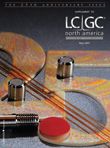Corporate Retrospective 2007: GL Science
My first contact with HPLC was at Mount Sinai Hospital, where our lab's budget miraculously allowed for a Waters gradient HPLC system.
My first contact with HPLC was at Mount Sinai Hospital, where our lab's budget miraculously allowed for a Waters gradient HPLC system. I attended a lecture by a Waters salesperson on linear versus nonlinear gradients, a hot topic in 1986. HPLC was new to our lab, and the chemists from surrounding labs stared with wonder as the system was assembled over a couple of days. I remember thinking how odd it was that a column would be encased in stainless steel instead of glass, as were the gravity-flow columns I was accustomed to packing.

In 1986, I landed a job with a nascent column supplier and was amazed to discover a journal devoted to HPLC and GC - LCGC North America. LCGC was an invaluable resource at a time when FAX machines were yet to be invented and even Al Gore had not considered the possibility of an Internet.
In those days, 300 × 3.9 mm columns packed with 10 micron irregular silicas dominated the market. A big question was whether customers would adopt smaller spherical particles. Three-micron phases remained toys for the truly courageous early adapters. I recall two friends, Csaba Horvath and Krishna Kalghatgi, who described the use of monodisperse particles of 2-μm diameter and smaller! I was tempted to pass this off as an academic dream, but here we are, almost two decades later, and the latest focus of ultra-HPLC fulfills their predictions.
In 1991, I started MetaChem Technologies, Inc., and my relationship with LCGC changed altogether. LCGC became our vehicle for letting the world know about our products, which we promoted with GL Sciences, Inc., a Japanese producer of HPLC columns. We were pleased to help usher in the high-purity silica revolution, largely a result of GL Sciences' research and production methods. GL Sciences' HPLC columns became the benchmark. LCGC was not only the top publication covering our industry but darn-near the only serious vehicle to showcase new HPLC and GC products to the world. We never had a moment of regret in our choice.
Now, having sold MetaChem, I'm proud to be President of GL Sciences, Inc., USA, founded in 2005 to promote GL Sciences' incredibly powerful HPLC columns. The changes have been exhilarating for me, but one thing has remained constant - the importance of LCGC as a vehicle for the chromatography community to take stock of itself and its future.
Congratulations and Happy Birthday, LCGC.
Chris Cantelmo
President
GL Sciences, Inc., USA
Torrance, California

A Novel LC–QTOF-MS DIA Method for Pesticide Quantification and Screening in Agricultural Waters
May 8th 2025Scientists from the University of Santiago de Compostela developed a liquid chromatography quadrupole time-of-flight mass spectrometry (LC–QTOF-MS) operated in data-independent acquisition (DIA) mode for pesticide quantification in agriculturally impacted waters.
Distinguishing Alcohol- from Non-Alcohol-Associated Liver Cirrhosis with LC-MS
May 7th 2025A pilot study investigating whether nicotinamide adenine dinucleotide kinase (NADK) expression is selectively diminished in alcohol-associated liver cirrhosis (AC), as well as evaluating its potential as a biomarker for this condition, measured AC and non-AC (NAC). Nicotinamide adenine dinucleotide (NAD+) and nicotinamide adenine dinucleotide phosphate (NADP+) levels in human liver samples were measured using liquid chromatography-mass spectrometry (LC-MS).
Detecting Hyper-Fast Chromatographic Peaks Using Ion Mobility Spectrometry
May 6th 2025Ion mobility spectrometers can detect trace compounds quickly, though they can face various issues with detecting certain peaks. University of Hannover scientists created a new system for resolving hyper-fast gas chromatography (GC) peaks.

.png&w=3840&q=75)

.png&w=3840&q=75)



.png&w=3840&q=75)



.png&w=3840&q=75)

















